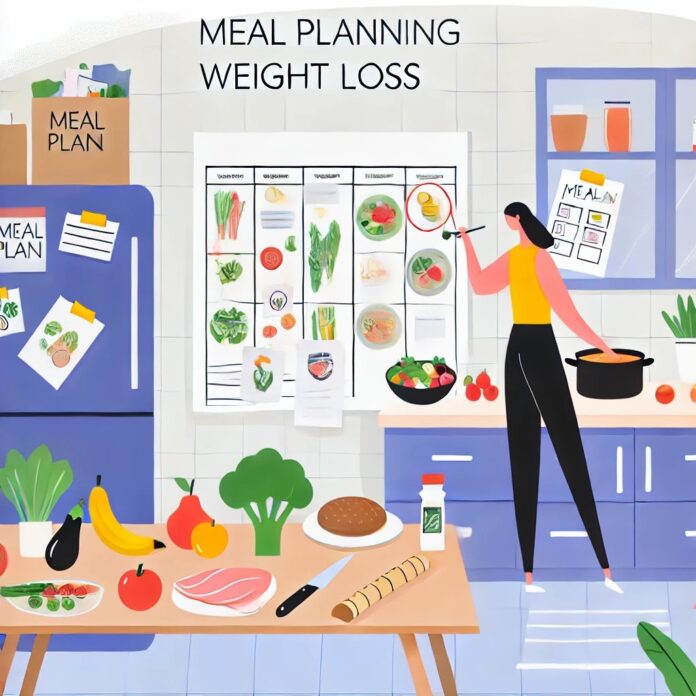Meal planning is a powerful tool for anyone looking to lose weight. By planning your meals ahead of time, you can control your calorie intake, ensure you’re getting the right nutrients, and avoid unhealthy eating habits. This guide will walk you through the benefits of meal planning, tips for getting started, and a sample meal plan to help you achieve your weight loss goals.
Benefits of Meal Planning for Weight Loss
Control Over Calorie Intake
One of the primary benefits of meal planning for weight loss is the ability to control your calorie intake. By planning your meals, you can ensure that you are consuming the right amount of calories to meet your weight loss goals.
Improved Nutrient Intake
Meal planning for weight loss helps you balance your diet and ensure you’re getting all the essential nutrients. This includes adequate amounts of protein, healthy fats, carbohydrates, vitamins, and minerals.
Reduced Food Waste
Planning your Meal planning for weight loss reduces food waste as you only buy what you need. This not only helps you save money but also contributes to a more sustainable lifestyle.
Less Stress
Having a plan for your Meal planning for weight loss can reduce the stress and decision fatigue associated with figuring out what to eat every day. This can help you stick to your diet more consistently.
How to Start Meal Planning for Weight Loss
Set Clear Goals
Before you start Meal planning for weight loss, set clear and realistic weight loss goals. Determine how much weight you want to lose and the timeframe in which you aim to achieve it.
Calculate Your Caloric Needs
To lose weight, you need to consume fewer calories than you burn. Use an online calculator to determine your daily caloric needs based on your age, gender, weight, height, and activity level.
Plan Balanced Meals
A balanced meal should include:
- Protein: Helps build and repair tissues, and keeps you feeling full. Include sources like chicken, fish, tofu, beans, and legumes.
- Healthy Fats: Important for overall health. Include sources like avocados, nuts, seeds, and olive oil.
- Carbohydrates: Provide energy. Opt for complex carbs like whole grains, fruits, and vegetables.
- Fiber: Helps with digestion and keeps you full. Include plenty of vegetables, fruits, and whole grains.
Prepare a Shopping List
Once you have planned your meals, prepare a shopping list. This will help you stay organized and ensure you have all the ingredients you need for the week.
Batch Cooking
Prepare multiple servings of your planned meals in advance. This can save you time during the week and make it easier to stick to your meal plan.
Portion Control
Be mindful of portion sizes to avoid overeating. Using smaller plates and measuring portions can help maintain proper serving sizes.
Sample Meal Plan for Weight Loss
Here’s a sample 7-day meal plan to help you get started. Adjust the portions based on your caloric needs.
Day 1
Breakfast: Greek yogurt with berries and a sprinkle of granola.
Lunch: Grilled chicken salad with mixed greens, cherry tomatoes, cucumbers, and a light vinaigrette.
Dinner: Baked salmon with quinoa and steamed broccoli.
Snack: Apple slices with almond butter.
Day 2
Breakfast: Oatmeal with sliced banana and a drizzle of honey.
Lunch: Turkey and avocado wrap with whole-grain tortilla, lettuce, and tomatoes.
Dinner: Stir-fried tofu with mixed vegetables and brown rice.
Snack: Carrot sticks with hummus.
Day 3
Breakfast: Smoothie with spinach, banana, protein powder, and almond milk.
Lunch: Quinoa salad with black beans, corn, red bell pepper, and lime dressing.
Dinner: Grilled shrimp with zucchini noodles and marinara sauce.
Snack: Handful of mixed nuts.
Day 4
Breakfast: Scrambled eggs with spinach and whole-grain toast.
Lunch: Lentil soup with a side of mixed greens.
Dinner: Chicken stir-fry with bell peppers, onions, and brown rice.
Snack: Greek yogurt with a drizzle of honey.
Day 5
Breakfast: Chia seed pudding with almond milk and fresh berries.
Lunch: Tuna salad with mixed greens, cherry tomatoes, and a light vinaigrette.
Dinner: Baked cod with sweet potato and steamed asparagus.
Snack: Sliced bell peppers with guacamole.
Day 6
Breakfast: Whole-grain toast with avocado and a poached egg.
Lunch: Chickpea salad with cucumbers, cherry tomatoes, and feta cheese.
Dinner: Beef and vegetable stir-fry with brown rice.
Snack: Cottage cheese with pineapple chunks.
Day 7
Breakfast: Smoothie bowl with blended berries, banana, and topped with granola.
Lunch: Grilled chicken and quinoa bowl with mixed vegetables.
Dinner: Spaghetti squash with turkey meatballs and marinara sauce.
Snack: Handful of trail mix.
Tips for Success
Stay Hydrated
Drinking enough water is essential for overall health and can help you feel full, reducing the likelihood of overeating.
Keep Healthy Snacks on Hand
Having healthy snacks readily available can prevent you from reaching for unhealthy options when you’re hungry between meals.
Track Your Progress

Keep a food diary or use a mobile app to track your meals and progress. This can help you stay accountable and make adjustments as needed.
Be Flexible
Life happens, and sometimes you may not be able to stick to your meal plan exactly. Allow for flexibility and don’t be too hard on yourself if you deviate occasionally.
Conclusion
Meal planning for weight loss is a practical and effective strategy to help you achieve your weight loss goals. By taking control of your diet, you can ensure that you are consuming the right amount of calories and nutrients, reducing stress, and avoiding unhealthy eating habits. Start today by setting clear goals, planning balanced meals, and staying consistent. With dedication and the right approach, you’ll be on your way to a healthier, slimmer you.


